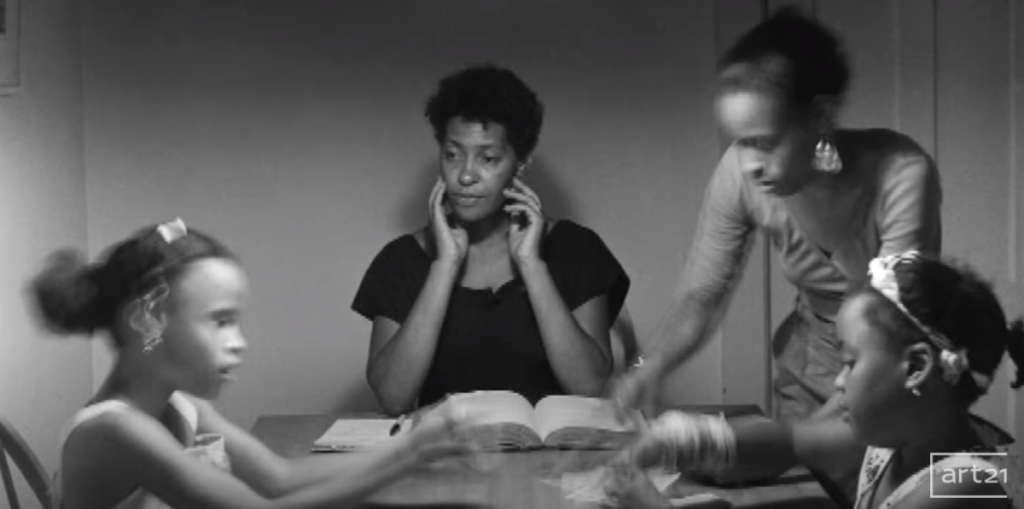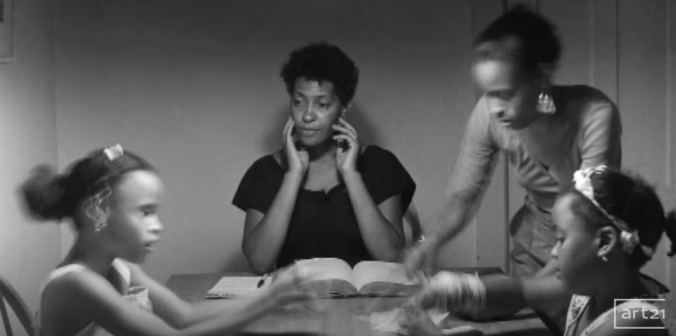In this essay, we’ll see how two famous photographers, Dawoud Bey and Carrie Mae Weems use photography to find their voices in the world. We’ll talk about the differences in style about their approach to find the voice within.
There are several ways Dawoud Bey approaches the idea of using photography as a way of finding his voice. First is that he captures images that resonate with the viewer through the use of visual senses and the environment. Second is that he attributes his expertise behind the camera to his hearing loss; he stated he tends to “see more” than most to compensate for his lack of hearing. We see Bey’s voice and talent be displayed in the Birmingham project. This project was about the fatal 1963 bombing by KKK members to a Baptist church in Birmingham, Alabama.

For the project, Bey paired two sets of portraits. One of the children the same age as the victims killed in the attack, another of adults the age of those same victims were they alive today. Accomplishing a display that impacts the viewer as they imagine how the victim would have looked if they were alive today. There is an image in particular that most impacted me from that project. It was the portrait of one of the young victims of the bombing. On the left-hand side, he was young and well-dressed; to the right, he was old and seemed respectable. Looking at these portraits, to the left I see a kid who is barely starting his life, and to the right is a picture of what he could have become if he were spared his life. When asked about his approach, Bey stated that he was interested in the idea of visualizing the past to make it resonate in the contemporary moment.

Contrasting, Carrie Mae Weems finds a way to use her photography to express the power she finds in her own environment. In “The Kitchen Table Series” Weems takes a series of images from her kitchen using a single light source; documenting everyday rites and passages of her family. She stated this is a way to project her voice through photography because wants the female viewer to feel empowered when seeing the series. It works because although women were only designated to the kitchen in the past, the kitchen is the heart of a home. We see this as we analyze the image of the series with three children gathered around the kitchen table and Weems is sitting in the center where she is the focal point. Here we can see the children are blurred because they are moving around, and Weems is static trying to aid the children with their school assignments, this is a great picture because her face could be interpreted as if she’s tired or worried. This shows her as vulnerable, yet shes empowered because her environment makes her feel safe.
The approaches of these two photographers are different. Bey conveys his message by adjusting the environment of the project and Weems uses the environment as is to project her message. I believe photography has the power to reshape the world because it allows the photographer to tell a story through a single image. The creativity, emotion, and sense that we get through photographs could move us to take action to fulfill our dreams and even to acknowledge a part of us that we never even knew about before.





Bey’s idea to put the two portraits together for the Birmingham project really makes the loss of those children’s lives visible and concrete.
One of the elements of the Kitchen Table series is that it makes the domestic relationships of everyday women important enough to be the subject of art. Often women’s experience has been thought of as trivial compared to say history-the subject of much of Bey’s work.